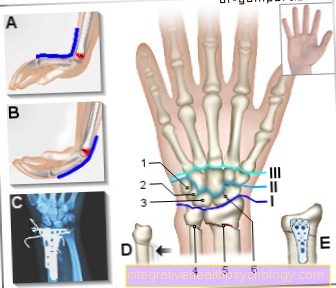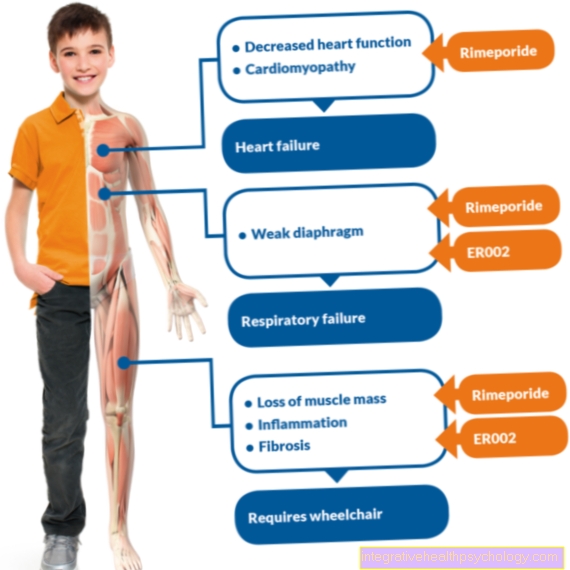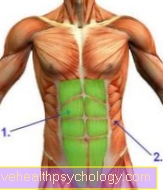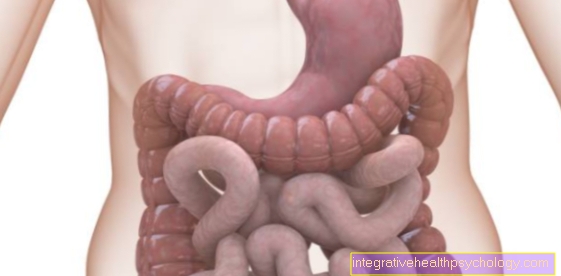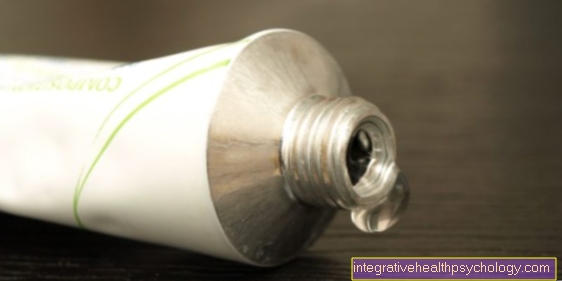Symptoms of the aortic aneurysm
introduction
Most of the time, aneurysms don't cause symptoms. This is the reason why up to 30% are discovered by accident through an ultrasound scan.
In 45% of the cases, the aortic aneurysm becomes symptomatic, causing back and flank pain and a feeling of pressure in the chest. Difficulty breathing and hotness can also occur, especially with aneurysms in the chest area. Abdominal aneurysms (aneurysms of the abdominal artery) can cause deceptive back pain that radiates to the thigh.

All possible symptoms of an aortic aneurysm
Symptoms of a thoracic aneurysm:
-
Often no symptoms
-
Chest pain
-
Back pain
-
to cough
-
hoarseness
-
Difficulty swallowing
-
Abnormal breathing noise (stridor)
-
Shortness of breath (dyspnoea)
-
Upper congestion of influence (cava superior syndrome)
-
Circulation disorders in the arms or in the brain
-
Cardiac arrhythmias
-
Heart failure
-
lung infection
Symptoms of an abdominal aortic aneurysm:
- Often no symptoms
-
Pain in the back, chest, lower abdomen
-
Flank pain radiating to the legs or back
-
Increased pulsation in the upper abdomen when touching
-
Visible pulsating swelling when lying down in slim sufferers
-
Sharp, persistent pain in the abdomen
-
Nausea, vomiting
General symptoms
- Microembolism
-
Macroembolism
Discomfort in the chest area
Chest pain
With a thoracic aneurysm, i.e. in an aneurysm in the area of the thoracic aorta, severe chest pain that resembles the symptoms of a heart attack can occur. The chest pain can be drawing, stabbing, or burning. If you feel chest pain, you should get a thorough examination. Because an advanced aortic aneurysm can tear and lead to death.
In the context of a rupture (tear) of the aorta, a sudden, violent pain in the chest is often described, which is felt to be unbearable (annihilation pain).
Also read the article: Chest pain
hoarseness
If an aortic aneurysm in the chest area presses a nearby nerve, the left recurrent laryngeal nerve, hoarseness can develop. The nerve runs on both sides of the chest, the left nerve close to the aorta. It is important for the function of the larynx.
If the left recurrent laryngeal nerve is pinched, the left vocal fold can no longer close and the affected person becomes hoarse. Hoarseness is noticeable through a rough, impure voice.
Find out all about the topic here: Hoarseness.
to cough
If the aneurysm is close to the windpipe, it can compress it. If the windpipe is partially or permanently narrowed at this point, symptoms such as coughing, shortness of breath and stridor (abnormal breathing noise) can occur. The irritation of the respiratory system causes an involuntary urge to cough. The cough is usually unproductive, i.e. without expectoration of mucus, and can be painful.
Swallowing disorder
If the aortic aneurysm in the chest is close to the esophagus, it can compress it. The pressure on the esophagus can cause swallowing disorders (dysphagia). There may be pain during or after swallowing.
Occasionally, those affected suffer from regurgitation. What this means is that the chyme that has just been swallowed flows from the esophagus back into the mouth.
Also read the article: The difficulty swallowing.
Shortness of breath
If a widespread aneurysm in the thoracic aorta constricts the windpipe, breathing in and out can be impeded. If the aneurysm becomes so large that it compresses the windpipe severely, it can cause shortness of breath. Those affected often feel that they cannot breathe enough air and, in return, breathe more intensely.
Difficulty breathing can be accompanied by symptoms such as nausea, dizziness and restlessness or even panic.
lung infection
If an aneurysm in the chest significantly narrows the airways, this can lead to recurring inflammation of the airways in addition to the symptoms such as shortness of breath, stridor and coughing.
Pneumonia is characterized by impaired lung function with difficulty breathing. The person concerned often breathes more often, has a fever and cough. Pneumonia is a serious complication and needs treatment.
Find out more about the topic here: The pneumonia.
Discomfort in the abdomen
The abdominal aortic aneurysm often goes unnoticed for a long time because the symptoms are very normal. It is often discovered accidentally during an abdominal ultrasound scan. If an abdominal aortic aneurysm is noticed, it is mostly because of pain. The pain can be located in the upper abdomen and radiate from the abdomen to the back or legs.
Abdominal pain has a stabbing, permanent pain that is present regardless of body position or position. When the aneurysm is about to burst, people feel sudden pain in the abdomen and back. One speaks of a pain that is so unbearable that one speaks of a "pain of destruction".
Find out more about the topic here: Pain in the abdominal artery.
Pulsation of the abdomen
The aorta is the main artery, the central artery, that pumps blood from the heart into the body. All arteries in our body basically have a pulse. This means that the ejections of blood from the heart cause a pressure wave that we can still feel on the wrist, for example.In healthy people, you usually do not see any pulsation in the abdomen, unless you are very slim.
A pulsation in the abdomen can be a sign of an extensive abdominal aortic aneurysm. With some affected people you can feel the increased pulsations, with others it can even be clearly visible when lying down.
Back pain
An aneurysm of the abdominal aorta often causes abdominal pain that radiates to the back or just back pain that is diffusely spread across the back. The pain can resemble lumbago or kidney colic. An aneurysm in the thoracic aorta can also cause back pain.
Back pain can be both occasional and permanent. Since back pain is a common symptom in Germany, an aneurysm is often overlooked as the cause. If the aneurysm ruptures, pain of destruction occurs, which usually radiates to the back.
For detailed information on this topic, see: Back pain
General complaints
Microembolism
A microembolism is a closure of small blood vessels by an embolus (embolus = endogenous / foreign object that leads to a vascular occlusion). The blood flow is changed in the area of an aortic aneurysm. Because of the bulging out of the vessel, the blood accumulates here. A build-up of blood favors the formation of blood clots and these can cause an embolism.
If a thrombus forms in the aortic aneurysm, which then closes a small blood vessel, this is called a microembolism. Microembolisms can be a warning signal for an aortic aneurysm and must be treated immediately.
For more information, read on: Embolism.
Macroembolism
If blood builds up in the aneurysm, a thrombus can develop, which in turn closes a large vessel. Then one speaks of a macroembolism. A macroembolism can be, for example, an embolism with occlusion of the large pulmonary vessels. An embolism must be identified and treated as early as possible.
Symptoms of an aortic rupture
An aortic rupture is the tear (rupture) of the vessel wall of the aorta. Those affected feel a sudden, very strong pain, which is also known as the pain of destruction. The unbearable pain can radiate into the back, pelvis and arms.
There is massive blood loss and the blood collects in the respective body cavity, that is, in the thoracic aortic aneurysm in the chest cavity and in the abdominal aortic aneurysm in the abdominal cavity. The blood presses on organs and possibly even on nerves. This can lead to a loss of sensitivity and symptoms of paralysis. If blood collects in the chest, it often presses on the pericardium, causing a pericardial effusion. If left untreated, the effusion leads to cardiac tamponade. So much blood collects in the pericardium that the heart is compressed and its cardiac function is disturbed. The circulation becomes unstable until it collapses with so-called shock symptoms. Sufferers get blood pressure and pulse falling, while the heart beats significantly faster. Often there is a feeling of shortness of breath. The oxygen supply to the brain becomes poor and the organs are insufficiently supplied.
An aortic rupture must be treated immediately. Otherwise, an aortic rupture will be fatal.
Find out more about the here Therapy of an aortic aneurysm.






